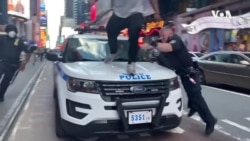ໃນຂະນະທີ່ຝູງຄົນຂະໜາດໃຫຍ່ເຕົ້າໂຮມກັນທ່າມກາງການປະທ້ວງໃນ ສະຫະລັດ ນັ້ນ, ມັນກໍມີຄວາມເປັນຫ່ວງເພີ່ມຂຶ້ນວ່າ ໄວຣັສໂຄໂຣນາ ຈະແຜ່ ລາມອອກໄປ, ກໍ່ໃຫ້ເກີດການຕິດແປດເພີ່ມ ເຕີມໃນຂະນະທີ່ລັດຕ່າງໆໄດ້ເປີດ ຄືນເສດຖະກິດຂອງເຂົາເຈົ້າ. ນັກຂ່າວວີໂອເອ ເຄນ ຟາຣາໂບ ໄດ້ລົມກັບຜູ້ ຊ່ຽວຊານດ້ານການແພດຫຼາຍຄົນ ໃນລັດ ອີລີນອຍ, ບ່ອນທີ່ ຄວາມວຸ້ນວາຍທາງເມືອງການ ແລະ ການປະທ້ວງ ໄດ້ບັງຄັບໃຫ້ສະຖານທີ່ກວດໄວຣັສໂຄໂຣນາ ຕ້ອງປິດໃນບາງຊຸມ ຊົນ, ເຊິ່ງຂັດຂວາງ ຄວາມພະຍາຍາມ ທີ່ຈະຕິດຕາມການແຜ່ລາມຂອງໄວຣັສດັ່ງກ່າວຕື່ມອີກ. ພຸດທະສອນ ມີລາຍລະອຽດມາສະເໜີທ່ານໃນອັນດັບຕໍ່ໄປ.
ໃນຂະນະທີ່ລາວໄດ້ເບິ່ງຄວາມວຸ້ຍວາຍເກີດຂຶ້ນໃນທົ່ວ ສະຫະລັດ ນັ້ນ, ພາຍ ໃຕ້ການກັກບໍລິເວນຫ້ອງການໃນບ້ານຂອງລາວໃນນະຄອນ ຊິຄາໂກ, ຜູ້ອຳ ນວຍການຂອງສະຖາບັນເພື່ອສຸຂະພາບໂລກ ຂອງມະຫາວິທະຍາໄລ ນອທ໌ ເວັສເຕິນ ດຣ. ໂຣເບີດ ເມີຟີ, ໄດ້ເລີ່ມທີ່ຈະສົງໄສວ່າ ທຸກຄົນໄດ້ລືມໃນທັນ ທີວ່າ ປະເທດ ແມ່ນກຳລັງຮັບມືກັບໂຣກລະບາດ ທີ່ອັນຕະລາຍນັ້ນແລ້ວຫຼືບໍ່.
ດຣ. ໂຣເບີດ ເມີຟີ ກ່າວວ່າ “ໂຄວິດ ມັນບໍ່ໄດ້ສົນໃຈ ກ່ຽວກັບ ການເມືອງ.ມັນມີແຕ່ມັກເຕັ້ນຈາກຄົນນຶ່ງໄປຫາອີກຄົນນຶ່ງ. ສະນັ້ນເຈົ້າກຳລັງເຮັດໃຫ້ຕົນ ເອງມີຄວາມສ່ຽງ.”
ມັນແມ່ນຂໍ້ຄວາມທີ່ເຈົ້າຄອງນະຄອນ ຊິຄາໂກ ທ່ານນາງ ລໍຣີ ໄລທຟຸດ ໄດ້ ກ່າວຢໍ້າໃນການກ່າວຄຳປາໄສປະຈຳວັນຕໍ່ສາທາລະນະ, ໃນວັນດຽວກັນທ່ານ ນາງໄດ້ສືບຕໍ່ດຳເນີນແຜນການເພື່ອຫຼຸດຜ່ອນການຫ້າມໃນເມືອງນັ້ນບໍ່ໃຫ້ອອກ ໄປໃສ ນັບຕັ້ງແຕ່ເດືອນມີນາເປັນຕົ້ນມາ ເພື່ອປ້ອງກັນ ການລະບາດຂອງໄວຣັສໂຄໂຣນາ, ເຖິງແມ່ນຈະມີຄວາມວຸ້ນວາຍດຳເນີນຢູ່ກໍຕາມ.
ເຈົ້າຄອງນະຄອນ ຊິຄາໂກ ທ່ານນາງ ລໍຣີ ໄລທຟຸດ ກ່າວວ່າ “ຄວາມສ່ຽງນັ້ນ ແມ່ນມີແທ້. ມັນມີຢູ່ ໃນປັດຈຸບັນ. ແລະມັນຈະຢູ່ກັບພວກເຮົາຕໍ່ໄປໃນອະນາຄົດ ທີ່ບໍ່ສາມາດແນມເຫັນໄດ້. ແລະ ເຈົ້າຕ້ອງມີຄວາມລະມັດລະວັງ ບໍ່ພຽງແຕ່ປົກ ປ້ອງຕົນເອງ ແລະ ຕ້ອງສຳລັບຄົນອື່ນໃນເຄືອຂ່າຍຂອງເຈົ້າດ້ວຍ, ໃນບ້ານ ຂອງເຈົ້າທີ່ເຈົ້າເປັນຫ່ວງ, ເພາະວ່າຕອນນີ້ເຈົ້າມີຄວາມສ່ຽງສູງທີ່ຈະຕິດ ໂຄວິດ-19.”
ດຣ. ໂຣເບີດ ເມີຟີ ຜູ້ອຳນວຍການໃຫຍ່ ສະຖາບັນເພື່ອສະພາໂລກ ມະຫາວິ ທະຍາໄລ ນອທ໌ເວັສເຕິນ ກ່າວວ່າ “ມັນຈະເຮັດໃຫ້ພວກເຮົາຖອຍຫຼັງ. ສະນັ້ນ ແທນທີ່ຈະສາມາດຄວບຄຸມໄວຣັສໄດ້, ຄືທີ່ພວກເຮົາໄດ້ຫວັງນັ້ນ, ຕອນນີ້ແມ່ນ ກຳລັງບໍ່ມີຄວາມກ້າວໜ້າ ຫຼື ຕື່ມຂຶ້ນໄປໜ້ອຍນຶ່ງ, ແຕ່ບໍ່ວ່າມັນຈະເປັນຫຍັງກໍ ຕາມ, ມັນກຳລັງດັນພວກເຮົາໃຫ້ຊ້າລົງ.”
ຄວາມສ່ຽງ ກ່ຽວກັບ ຄວາມຮຸນແຮງ ແລະ ການທຳລາຍທີ່ເພີ່ມຂຶ້ນໄດ້ເຮັດໃຫ້ ພະແນກສາທາລະ ນະສຸກຂອງລັດ ອີລີນອຍ ຕ້ອງປິດສະຖານທີ່ກວດ ໂຄວິດ-19 ໃນຊຸມຊົນຊົ່ວຄາວ, ເລື່ອນການແຈ້ງຜົນການກວດໂຣກເປັນຜົນບວກ ແລະ ລົບ ກວນຄວາມສາມາດຂອງປະຊາຄົມການແພດ ເພື່ອຕິດຕາມການແຜ່ລາມ ຂອງໄວຣັສ.
ດຣ. ໂຣເບີດ ເມີຟີ ກ່າວວ່າ “ເຫັນໄດ້ຊັດວ່າມັນຈະພັງທະລາຍ ເພາະວ່າພວກ ເຮົາບໍ່ໄດ້ກວດໂຣກ ຫຼາຍຄົນພໍ. ປະຊາຊົນແມ່ນຢ້ານທີ່ຈະອອກໄປຂ້າງນອກ. ເຈົ້າໄປຮອດໃສກະບໍ່ໄດ້ຢູ່ໃກ້ກັບຕົວເມືອງນັ້ນ. ມັນມີການແຜ່ລະບາດໃນທົ່ວຕົວ ເມືອງ. ເຂົາເຈົ້າແມ່ນກຳລັງຢູ່ໃນບ້ານຫຼາຍກວ່າແຕ່ກ່ອນ.”
ເວລາທີ່ເຕົ້າໂຮມກັນຢູ່ຂ້າງນອກ, ຮອງສາສະດາຈານ ກ່ຽວກັບ ດ້ານຢາ ແລະ ໂຣກຕິດຕໍ່ທີ່ມະຫາວິທະຍາໄລ ຣັຊ ດຣ. ໄມເກິລ ລິນ ເວົ້າວ່າ ການກວດໂຣກ ເບິ່ງຄືວ່າຈະກັບຄືນມາຢູ່ລະດັບກ່ອນການກວດໂຣກອີກ ຖ້າບໍ່ມີການຂະຫຍາຍ ຕົວ, ແຕ່ຄວາມເຂົ້າໃຈ ກ່ຽວກັບ ວິທີທີ່ຄວາມວຸ້ນວາຍໃນປັດຈຸບັນນີ້ໃນ ສະຫະ ລັດ ຈະສົ່ງຜົນກະທົບຕໍ່ການລະບາດ ຂອງໄວຣັສນັ້ນ ຈະບໍ່ເກີດຂຶ້ນຢ່າງກະທັນ ຫັນ.
ດຣ. ໄມເກິລ ລິນ ກ່າວວ່າ “ຖ້າມີການຕິດໂຣກເພີ່ມຂຶ້ນໃດໆ ມັນອາດເກີດຂຶ້ນ ໃນເວລາໃດນຶ່ງປະ ມານ 1 ຫຼື ສອງອາທິດຫຼັງຈາກການເຕົ້າໂຮມກັນ. ປົກກະຕິ ມັນຈະກ່ຽວກັບ ເວລາທີ່ມັນໃຊ້ ສຳລັບການຕິດໂຣກ ທີ່ຈະຟັກຕົວ, ສະແດງອາ ການ, ແລະ ກາຍເປັນຮຸນແຮງພໍທີ່ຄົນຕ້ອງການການເບິ່ງ ແຍງຢູ່ໂຮງໝໍ.”
ແຕ່ ດຣ. ລິນ ໄດ້ໃຫ້ຄວາມຫວັງທີ່ເປັນຕາຢ້ານວ່າ ການລະບາດຂອງໄວຣັສ ອາດຈະບໍ່ຈຳກັດຢູ່ໃນບັນດາຜູ້ປະທ້ວງເທົ່ານັ້ນ.
ດຣ. ໄມເກິລ ລິນ ກ່າວວ່າ “ການຢູ່ນອກບ້ານ ແທນທີ່ຈະຢູ່ໃນບ້ານ ແທ້ຈິງ ແລ້ວອາດເປັນສິ່ງທີ່ເຂົ້າຂ້າງພວກເຮົາຈາກທັດສະນະຄະຕິ ກ່ຽວກັບ ການຄວບ ຄຸມການຕິດໂຣກ. ເພາະພວກເຮົາຮູ້ວ່າ ການແຜ່ເຊື້ອສ່ວນຫຼາຍມີແນວໂນ້ມວ່າ ຈະເກີດຢູ່ໃນບ້ານ ບ່ອນທີ່ມີການລະບາຍອາກາດບໍ່ດີ. ການຢູ່ໃນບ້ານພ້ອມດ້ວຍ ອາກາດເປົ່າໄປທົ່ວອາດຈະມີຄວາມສ່ຽງໃນການແຜ່ເຊື້່ອໜ້ອຍກວ່າ. ດ້ວຍແສງ ແດດຢູ່ນອກບ້ານ, ແສງ UV ແທ້ຈິງແລ້ວ ຈະສາມາດຂ້າໄວຣັສໄດ້. ແຕ່ເມື່ອ ເວົ້າເຖິງການສົ່ງຕໍ່ໂຣກ, ມັນກໍຍາກແທ້ໆທີ່ຈະເດົາໄດ້.”
ວິດີໂອຈາກການປະທ້ວງໄດ້ສະແດງໃຫ້ເຫັນຄົນໃສ່ໜ້າກາກຢ່າງກວ້າງຂວາງ ແຕ່ບໍ່ແມ່ນໝົດທຸກຄົນ ທີ່ມັນສາມາດຈຳກັດການປ່ອຍເຊື້ອໂຣກໃນອາກາດ.
ດຣ. ໂຣເບີດ ເມີຟີ ກ່າວວ່າ “ມັນຈະໄດ້ຜົນຖ້າທຸກຄົນໃສ່ໜ້າກາກເທົ່ານັ້ນ. ມັນຕ້ອງເປັນໝົດທຸກຄົນ ບໍ່ເຊັ່ນນັ້ນ ມັນກໍຈະບໍ່ມີຄວາມໝາຍຫຍັງ.”
ໃນຂະນະທີ່ຕົວເລກການຕິດໄວຣັສໂຄໂຣນາໃນ ສະຫະລັດ ແມ່ນໃກ້ຈະຮອດ 2 ລ້ານຄົນແລ້ວນັ້ນ, ປະຊາຊົນ ອາເມຣິກັນ ແມ່ນກຳລັງທ້າຄວາມສ່ຽງ ໃນຂະ ນະທີ່ກຳລັງປະຕິບັດສິດທິໃນການປະທ້ວງ. ໃນຂະນະດຽວກັນ ຂໍ້ມູນການສຳ ຫຼວດຄວາມຄິດເຫັນໄດ້ສືບຕໍ່ສະແດງໃຫ້ເຫັນວ່າ ປະ ຊາຊົນສ່ວນຫຼາຍເຫັນວ່າ ການຍັບຢັ້ງ ໂຄວິດ-19 ແມ່ນບູລິມະສິດສູງສຸດ.
As large crowds gather amid protests in the United States, concern is growing that the coronavirus will spread, creating more clusters of infection as states reopen their economies. VOA's Kane Farabaugh spoke with several medical experts in Illinois, where civil unrest and protests forced coronavirus testing sites to close in some communities, further hampering efforts to monitor the spread of the virus.
As he watched unrest unfold across the United States, under lockdown from his home office in Chicago, the director of Northwestern University’s Institute for Global Health, Dr. Robert Murphy, began to wonder if everyone had suddenly forgotten the country was dealing with a dangerous pandemic.
“COVID Doesn’t care about politics. It just likes to jump from person to person. // So you are putting yourself at risk.”
It was a message Chicago’s mayor, Lori Lightfoot, echoed in her daily address to the public, on the same day she moved ahead with plans to loosen restrictions in the city - in place since March to prevent the spread of the coronavirus - despite continuing unrest.
"That risk is real. It is present. And it will be with us for the foreseeable future. And you need to take the precautions not only just to protect yourself, but for others in your network, in your home that you care about, because now you are at heightened risk of COVID-19 infection."
“This is setting us backwards. So instead of being able to control the virus, like we had hoped, now it’s either going to plateau, or go up a little bit, but whatever it is, it’s pushing us way down the timeline.”
The risk of increasing violence and destruction led the Illinois Department of Public Health to temporarily close community COVID-19 testing facilities, delaying notifications of positive test results and interrupting the medical community’s ability to track the virus’ spread.
06:50 “It will obviously go down because we aren’t testing as many people. People are afraid to go out. You can’t even get anywhere near the downtown. There’s flare ups all around the city. They are staying home now more than ever.”
When the gatherings subside, Rush University Associate Professor of Medicine and Infectious Disease Dr. Michael Lin says testing will likely return to pre-protest levels if not increase, but understanding how the recent unrest in the U.S. will impact the spread of the virus won’t be immediate.
03:01 “If there is any spike it may happen sometime about a week or two weeks after the gatherings. That’s usually about the time it takes for the infection to incubate, manifest symptoms, and become severe enough that people need hospital care.”
But Dr. Lin offers a glimmer of hope that virus spread might be limited among protesters.
03:38 “Being outdoors instead of indoors may actually be something that’s favorable for us from the standpoint of infection control. Cause we know that a lot of spread tends to happen in indoor areas where there is poor ventilation. In the outdoors, with the air blowing around there may be less risk of spread. With the sun being out, UV rays can actually also kill the virus. But when it comes to transmission, it’s really difficult to predict.”
Video of demonstrations show widespread but not universal use of masks that can limit the expulsion of germs in the air.
“It only works if everyone is wearing a mask. It has to be all or nothing.”
As the number of coronavirus infections in the U.S. nears two million, some Americans are weighing health risks while exercising their right to demonstrate. Meanwhile polling data continue to show clear majorities view curbing COVID-19 as a priority.





